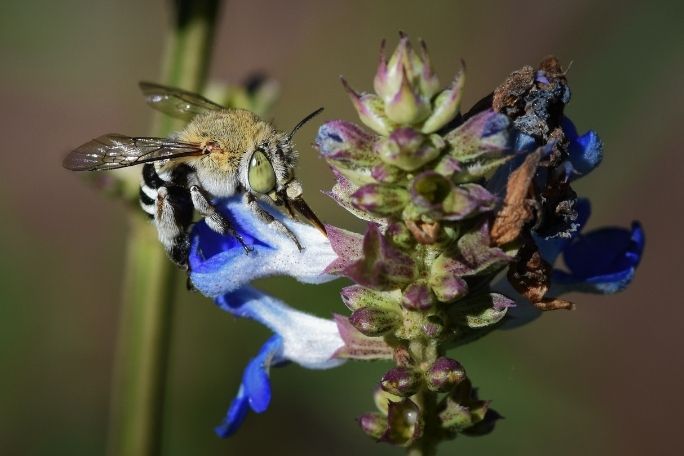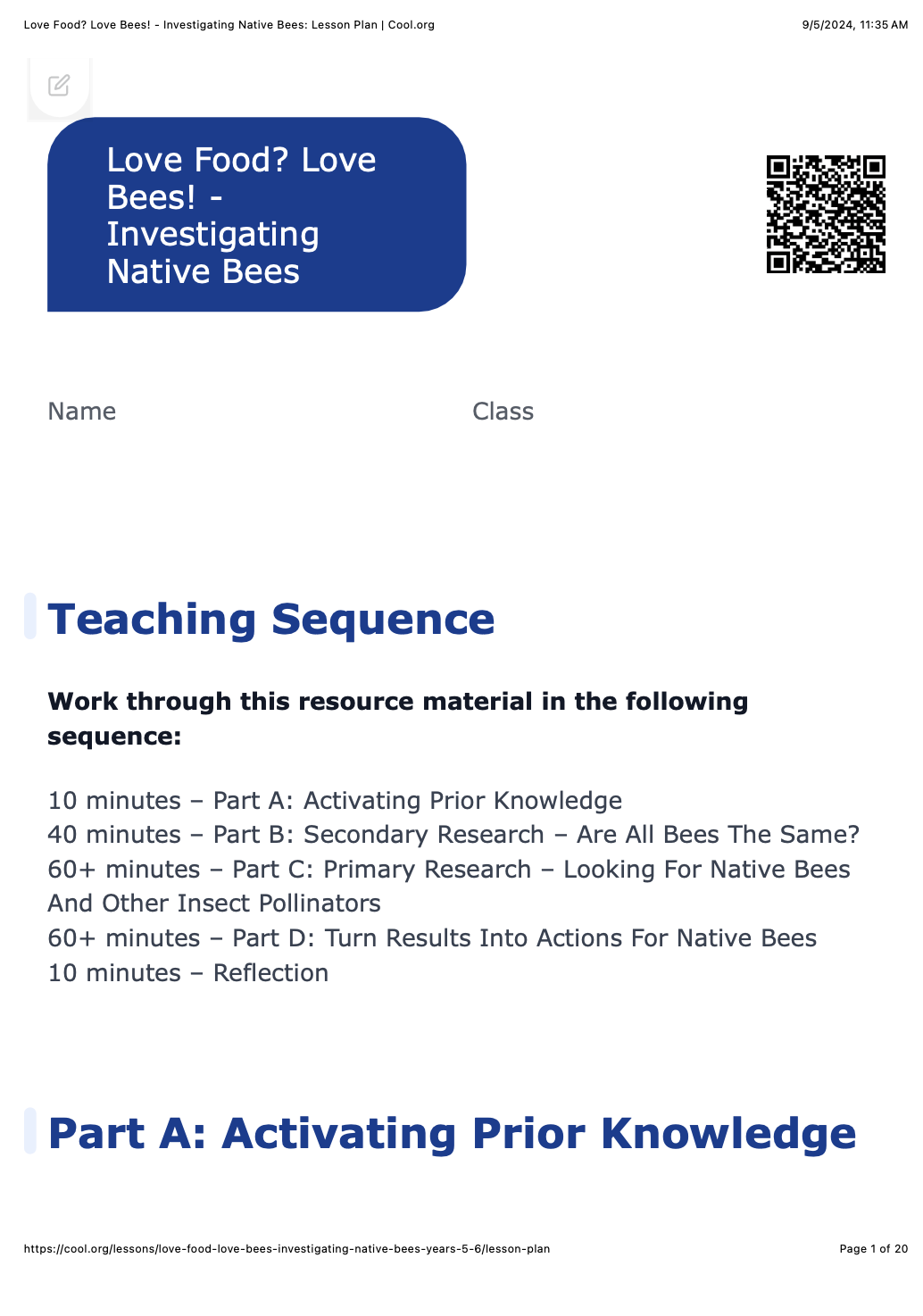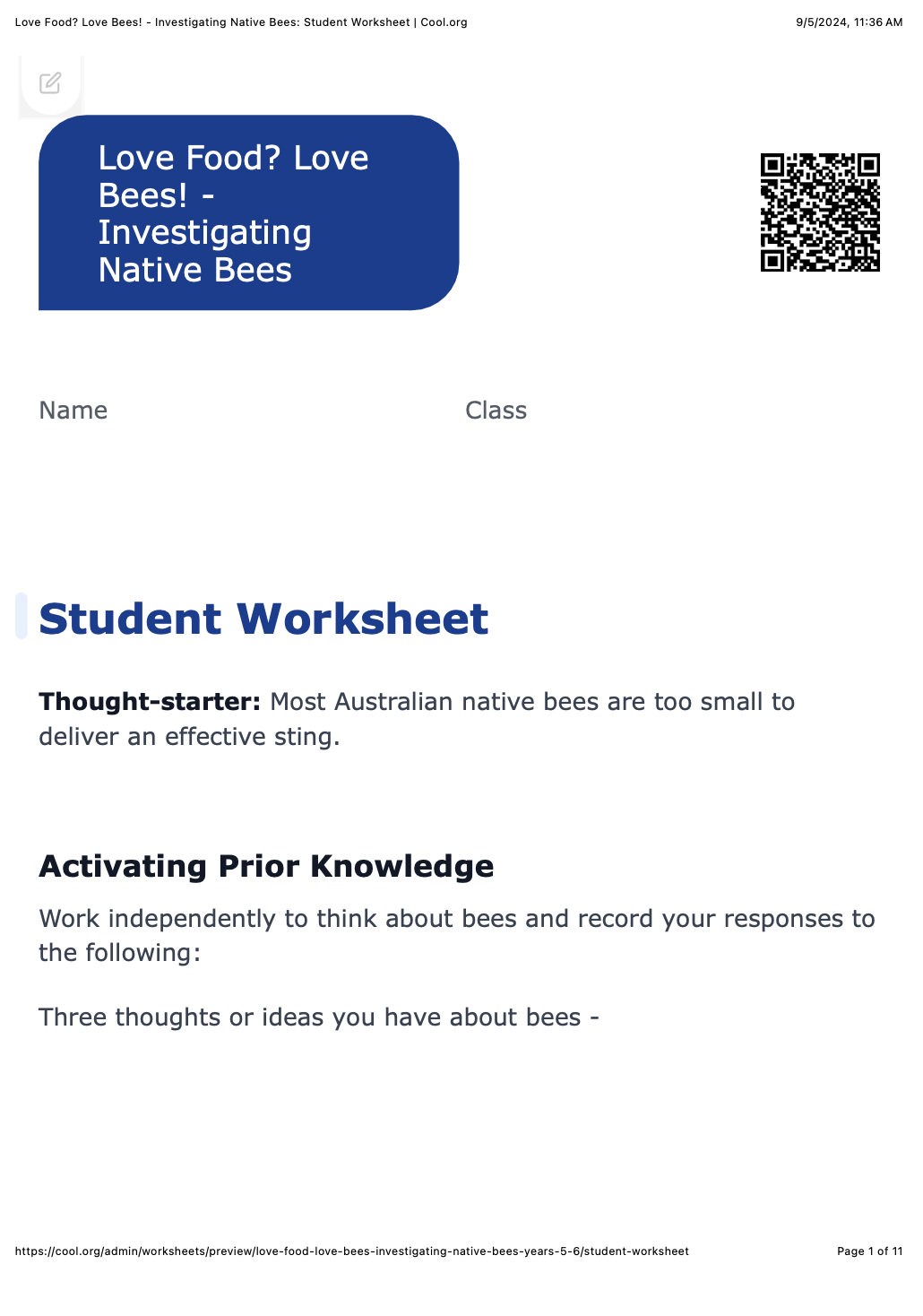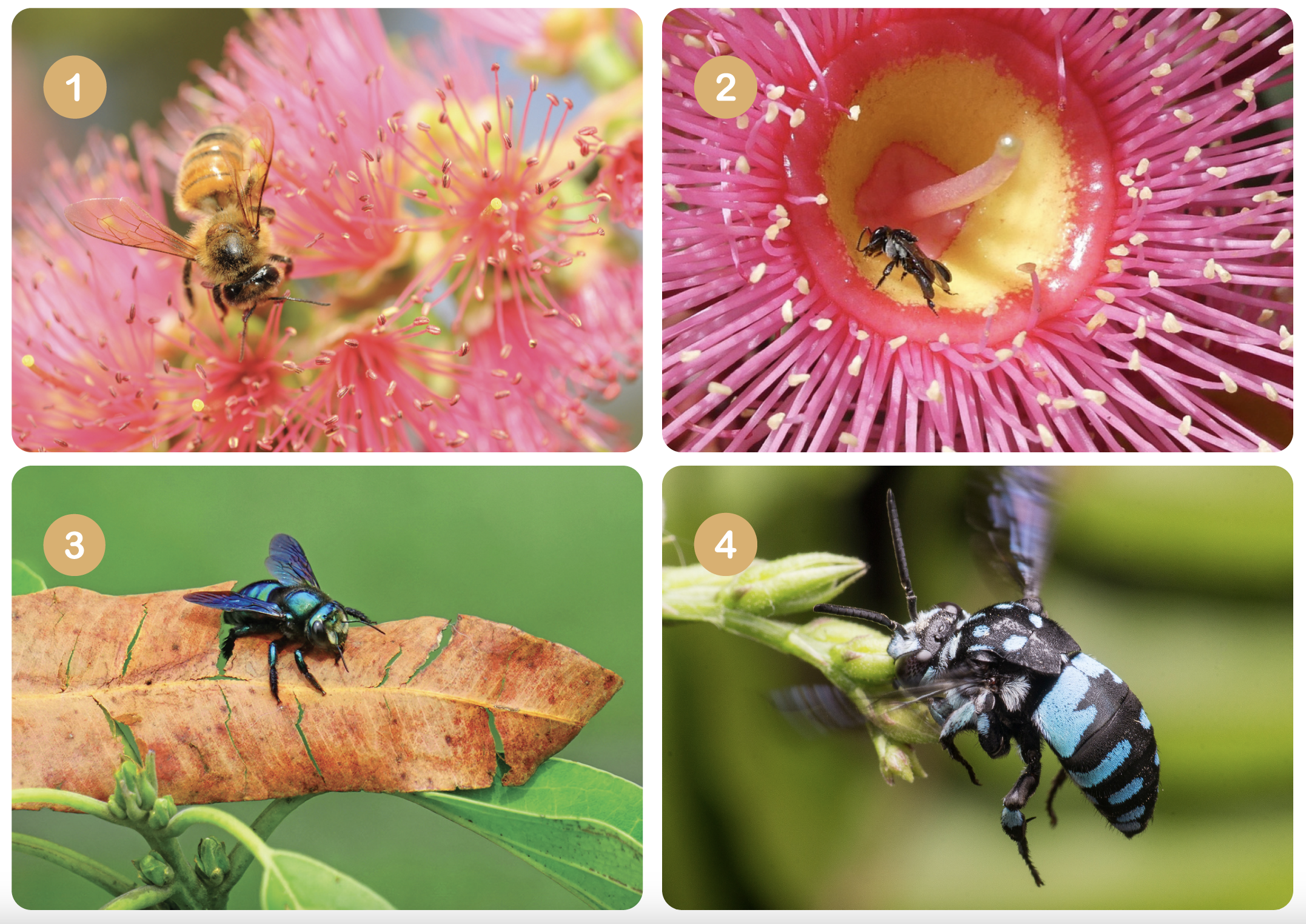Lesson summary
Students develop an understanding of the importance of native bees and propose actions to protect them. They begin by working collaboratively to undertake secondary research in order to create a class library about native bees. They then undertake primary research by completing a native bee survey at their school. Based on the results of their primary and secondary research, students propose actions to protect native bees at their school and produce a communication piece to share their ideas with the school community.
Learning intentions:
Students will...
- understand the difference between European honey bees and Australian native bees
- recognise the value of native bees to both the natural environment and to agriculture.
Success criteria:
Students can...
- distinguish between an Australian native bee and a European honey bee
- draw conclusions about research results, propose actions in response to results and communicate findings and proposed actions.
Lesson guides and printables
Curriculum links
Select your curriculum from the options below.
Curriculum Mapping
Australian curriculum content descriptions:
Year 5 Science:
- Living things have structural features and adaptations that help them to survive in their environment (ACSSU043)
- Identify, plan and apply the elements of scientific investigations to answer questions and solve problems using equipment and materials safely and identifying potential risks (ACSIS086)
- Compare data with predictions and use as evidence in developing explanations (ACSIS218)
- Communicate ideas, explanations and processes using scientific representations in a variety of ways, including multi-modal texts (ACSIS093)
Year 6 Science:
- Identify, plan and apply the elements of scientific investigations to answer questions and solve problems using equipment and materials safely and identifying potential risks (ACSIS103)
- Compare data with predictions and use as evidence in developing explanations (ACSIS221)
- Communicate ideas, explanations and processes using scientific representations in a variety of ways, including multi-modal texts (ACSIS110)
Year 5 HASS:
- Locate and collect relevant information and data from primary sources and secondary sources (ACHASSI095)
- Evaluate evidence to draw conclusions (ACHASSI101)
- Work in groups to generate responses to issues and challenges (ACHASSI102)
- Reflect on learning to propose personal and/or collective action in response to an issue or challenge, and predict the probable effects (ACHASSI104)
- Present ideas, findings, viewpoints and conclusions in a range of texts and modes that incorporate source materials, digital and non-digital representations and discipline-specific terms and conventions (ACHASSI105)
Year 6 HASS:
- Locate and collect relevant information and data from primary sources and secondary sources (ACHASSI123)
- Evaluate evidence to draw conclusions (ACHASSI129)
- Work in groups to generate responses to issues and challenges (ACHASSI130)
- Reflect on learning to propose personal and/or collective action in response to an issue or challenge, and predict the probable effects (ACHASSI132)
- Present ideas, findings, viewpoints and conclusions in a range of texts and modes that incorporate source materials, digital and non-digital representations and discipline-specific terms and conventions (ACHASSI133)
Syllabus outcomes: ST3-10LW, ST3-4WS, GE3-4.
General capabilities: Literacy, Critical and Creative Thinking.
Cross-curriculum priority: Sustainability
Relevant parts of Year 5 Science achievement standards: Students analyse how the form of living things enables them to function in their environments. They compare patterns in their data with predictions when suggesting explanations. They communicate their ideas and findings using multimodal texts.
Relevant parts of Year 6 Science achievement standards: Students collect, organise and interpret their data, and construct multimodal texts to communicate ideas, methods and findings.
Relevant parts of Year 5 HASS achievement standards: Students locate and collect data and information from a range of sources to answer inquiry questions. They interpret data to identify and describe distributions, simple patterns and trends, and to infer relationships and suggest conclusions based on evidence. They work with others to generate alternative responses to an issue or challenge. They present their ideas, findings and conclusions in a range of communication forms.
Relevant parts of Year 6 HASS achievement standards: Students locate and collect useful data and information from primary and secondary sources. They interpret data to identify, describe and compare distributions, patterns and trends, and organise and represent data in a range of formats. They collaboratively generate alternative responses to an issue. They present ideas, findings, viewpoints and conclusions in a range of communication forms.
This lesson is part of the wider unit of work Love Food? Love Bees! – Integrated Unit – Years 5 & 6.
Time required: 180+ mins (will depend on the number of observation sites you have to visit, the number of times you visit each site, and the communication pieces students create and how you choose to share them).
Level of teacher scaffolding: Medium to high – Supervise class discussions, oversee bee observation activities, lead students in creating communication pieces.
UN Sustainable Development Goals
- Target 15.5: Take urgent and significant action to reduce the degradation of natural habitats, halt the loss of biodiversity and, by 2020, protect and prevent the extinction of threatened species.
Resources Required
- Bee Images (optional)
- Device capable of presenting a website to the class
- Devices with internet access for students to conduct research
- Insect Pollinator Observation Sheet
- Materials for creating communication piece (e.g. art materials, devices)
- Materials for classroom native bee library (e.g. display book, devices with internet access, folders)
- Native Bee Visual Explainer (optional)
- Native Pollinator Key
- Outdoor Learning Tips
- Solitary Bee Homes Factsheet
- Student Worksheets – one copy per student.
Additional Info
This lesson has been created in partnership with ACT for Bees. ACT for Bees is a not-for-profit organisation taking action to preserve these essential pollinators, ensuring a food-secure future.
Related Professional Learning
How To Teach Sustainability With Hope
Quick summary: This course is for both primary and secondary teachers of all subjects, but especially for English, Science, Humanities and Geography teachers who are covering climate change and the cross-curriculum priority of sustainability.





Welcome back!
Don't have an account yet?
Log in with:
Create your free Cool.org account.
Many of our resources are free, with an option to upgrade to Cool+ for premium content.
Already have an account?
Sign up with:
By signing up you accept Cool.org's Terms and Conditions(Opens in new tab) and Privacy Policy(Opens in new tab).